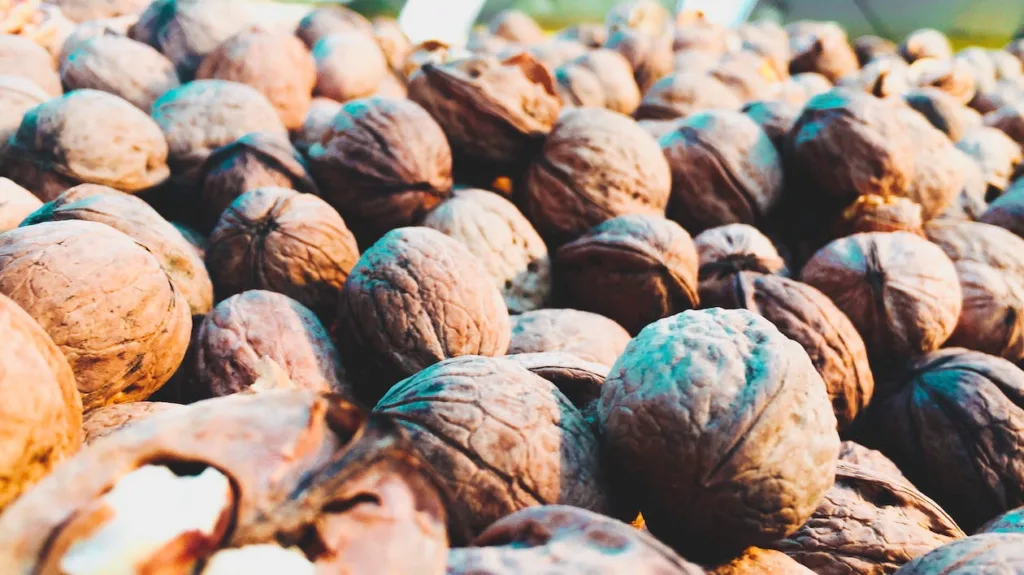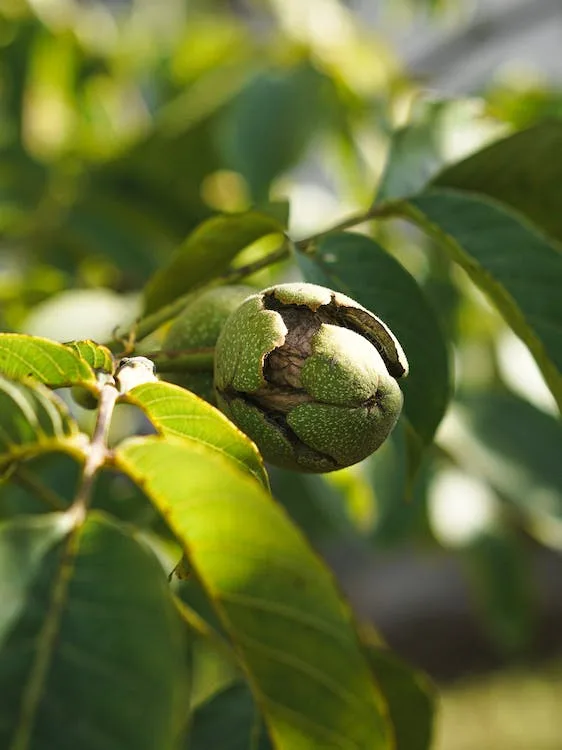“What if Walnut Could Transform Your Life? How They Slash Cholesterol, Prevent Cancer, and Stop Hair Fall – Uncover the Secrets Now!”
What is History of Walnut ?
Walnuts, those iconic brain-shaped nuts, have a history that stretches back thousands of years. These nuts, believed to have originated in what we now call Iran, have held a special place in human cuisine since as far back as 7000 BCE.
The ancient Greeks and Romans were captivated by their delightful taste and intriguing resemblance to the human brain. These civilizations relished walnuts not only for their flavor but also for their versatility in the kitchen. Walnuts gradually gained popularity in European culinary traditions, known not just for their rich taste but also for their prized oil, which added depth to a wide array of dishes.
The Age of Exploration in the 15th and 16th centuries played a pivotal role in spreading walnut trees to distant corners of the world. European explorers introduced these trees to the Americas, Asia, and Africa, cementing their global appeal. In Asian cultures, walnuts symbolized good fortune and fertility, adding cultural significance to their culinary charm.

Fast forward to the present day, and walnuts have garnered the status of a superfood. Packed with essential nutrients such as protein, fiber, antioxidants, and omega-3 fatty acids, they offer a myriad of health benefits. Whether enjoyed as a satisfying snack or incorporated into a variety of dishes, walnuts continue to be a beloved and nourishing part of modern diets.
where walnut is Found?
Walnuts (Juglans regia) are native to a broad region spanning from southeastern Europe to eastern Asia. They can be found in several countries across Europe and Asia. Here is a list of countries where walnut trees are commonly found:
China: China is the world’s largest producer of walnuts. Many regions, including Shaanxi, Xinjiang, and Gansu, cultivate walnut trees.
United States: The United States is also a significant producer of walnuts, with California being the primary walnut-producing state. Other states, such as Oregon and Arizona, also have walnut orchards.
Iran: Walnuts are believed to have originated in the region that is now modern-day Iran. Iran continues to be a major producer of walnuts.
Turkey: Turkey is another prominent producer of walnuts, particularly in regions like Antalya, Aydin, and Manisa.
India: India cultivates walnuts in the northern regions of Jammu and Kashmir and Himachal Pradesh.
France: France, especially the regions of Perigord and Grenoble, is known for its high-quality walnuts, often used in French cuisine.
Greece: Walnuts are cultivated in several parts of Greece and are used in traditional Greek dishes and desserts.
Italy: Italy is known for its production of high-quality walnuts, especially in the regions of Campania and Sicily.

Chile: In South America, Chile is a notable producer of walnuts.
Romania: Romania is one of the leading walnut producers in Europe.
Ukraine: Ukraine also has a significant walnut industry, particularly in the western part of the country.
Azerbaijan: Walnuts are cultivated in Azerbaijan, where they are often used in traditional Azerbaijani cuisine.
These are just some of the countries where walnuts are commonly found. Walnuts are a versatile and nutritious nut used in a wide range of culinary applications, from baking and cooking to snacking and garnishing dishes.
Where do walnut trees grow in India?
Walnut trees are primarily grown in the northern regions of India, particularly in the states of Jammu and Kashmir, Himachal Pradesh, and Uttarakhand. These states offer suitable climate and elevation conditions for the cultivation of walnut trees. The Kashmir Valley, in particular, is well-known for its high-quality walnuts.
In these northern regions, walnut trees thrive in temperate climates with cold winters and moderate summers. The hilly and mountainous terrain, along with well-drained soil, provides ideal growing conditions for walnut trees. Walnut cultivation is an important agricultural activity in these areas, and the region produces a significant quantity of walnuts for both domestic consumption and export.
Does walnut grow in Kashmir?
Yes, walnuts do grow in Kashmir, particularly in the northern regions of Jammu and Kashmir, India. The Kashmir Valley, in particular, is known for its walnut cultivation. The climate and soil conditions in this region are conducive to growing high-quality walnuts. Kashmiri walnuts are renowned for their taste and quality and are used in various culinary preparations and traditional dishes. The walnut trees in Kashmir contribute significantly to the region’s agricultural economy and provide valuable produce for both domestic consumption and export.
Where are walnuts grown in Kashmir?
In Kashmir, walnuts are primarily grown in various districts and areas within the Kashmir Valley, which is known for its high-quality walnuts. Some of the key walnut-producing regions and districts in Kashmir include:

Srinagar: The capital city of Jammu and Kashmir, Srinagar, and its surrounding areas are important walnut-growing regions. Many walnut orchards are found in the vicinity of Srinagar.
Anantnag: This district in southern Kashmir is known for its walnut production. It is home to several walnut orchards that produce high-quality walnuts.
Baramulla: Located in the northern part of the Kashmir Valley, Baramulla is another significant walnut-producing region.
Pulwama: Pulwama district, known for its scenic beauty, also has a substantial walnut cultivation industry.
Budgam: Walnut trees are cultivated in the Budgam district, which is located in the central part of the valley.
Kupwara: This district in the northern part of Kashmir is also known for its walnut orchards.
These regions benefit from the favorable climate and terrain of the Kashmir Valley, with its cold winters and moderate summers, making it suitable for walnut cultivation. Kashmiri walnuts are renowned for their quality and are in high demand both domestically and internationally.
During which season are walnut harvest in Jammu and Kashmir?
Walnut harvesting in Jammu and Kashmir typically occurs in the late summer and early autumn months. The harvest season for walnuts in the region usually spans from late August to early October. During this time, the walnuts have matured and are ready for harvesting.
The exact timing of the walnut harvest can vary somewhat depending on factors such as the local climate, altitude, and the specific variety of walnut being grown. However, in most parts of Jammu and Kashmir, you can expect to see walnut harvesting activities taking place in the late summer and early fall, with farmers and orchard owners collecting the ripe nuts from the trees.
Which is best quality walnut in India?
The best-quality walnuts in India are often associated with the Kashmir region. Kashmiri walnuts, also known as Kashmiri Akhrot or Kashmiri Kagzi Walnuts, are highly regarded for their superior quality and taste. These walnuts are known for their unique flavor, thin shells, and rich, creamy texture. Kashmiri walnuts are often considered some of the finest walnuts available in India and are highly sought after both in domestic and international markets.
The specific variety of walnut commonly grown in Kashmir is Juglans regia, or the English walnut. The climate and geographical conditions of the Kashmir Valley, including the cold winters and moderate summers, contribute to the exceptional quality of these walnuts.

While Kashmiri walnuts are renowned for their quality, other regions in India, such as Himachal Pradesh and parts of Uttarakhand, also produce walnuts of good quality. However, when it comes to the reputation for the best quality, Kashmiri walnuts tend to be the most highly regarded in the country.
What is the price of Kashmiri walnut per kg?
The price of Kashmiri walnuts per kilogram (kg) can vary depending on several factors, including the quality of the walnuts, the specific variety, the grade, the packaging, and the market conditions. Additionally, prices can fluctuate from year to year due to factors like crop yields and demand.
Which walnut is best Kashmiri, Chinese or California walnut?
The preference for the best walnut variety, whether Kashmiri, Californian, or Chinese, often comes down to individual taste and specific culinary uses. Each variety has its unique characteristics, and what is considered “best” can vary from person to person. Here’s a brief comparison of the three varieties:
Kashmiri Walnuts :
Known for their thin shells and rich, creamy texture.Highly regarded for their flavor and quality.Often used in traditional Indian sweets and cuisine.Prized for their unique taste and premium quality.
Californian Walnuts :
California is one of the world’s largest producers of walnuts.Californian walnuts are larger in size and have thicker shells compared to Kashmiri walnuts.They have a mild, slightly sweet flavor.Commonly used in a wide range of culinary applications, including baking, snacking, and cooking.
Chinese Walnuts (Juglans sigillata or Juglans cathayensis):
Chinese walnuts are a different species from Juglans regia, which is the species of both Kashmiri and Californian walnuts.They have a different flavor profile and texture compared to the other two varieties.Chinese walnuts are often used in traditional Chinese dishes and medicine.
Ultimately, the “best” walnut variety depends on your personal taste preferences and how you plan to use them in your cooking or snacking. Some people may prefer the rich and creamy texture of Kashmiri walnuts for traditional Indian sweets, while others may prefer the milder taste and larger size of Californian walnuts for baking or snacking. Chinese walnuts are less common outside of China but have their own culinary uses within Chinese cuisine.
It’s a matter of personal preference, and you can experiment with all three varieties to determine which one suits your needs and taste the best.
What is Kashmiri walnut called?
Kashmiri walnuts are often referred to by several names, including:
Kashmiri Walnut: In kashmiri Language this is called ‘DON’
Kashmiri Akhrot: “Akhrot” is a Hindi word for walnuts, so “Kashmiri Akhrot” specifically denotes walnuts from Kashmir.
Kashmiri Kagzi Walnuts: “Kagzi” means “paper-thin” in Hindi, and this name emphasizes the thin shells of Kashmiri walnuts.
Kashmiri Jungli Akhrot: “Jungli” means “wild” in Hindi, and this term may be used to refer to wild or naturalized walnut trees in the Kashmir region.
These names are used interchangeably to describe walnuts from Kashmir, which are known for their high quality and unique characteristics, including thin shells and rich flavor.
How many walnuts can eat a man every day?
The number of walnuts a person can eat in a day depends on various factors, including individual dietary preferences, nutritional needs, and overall calorie intake. Walnuts are a nutritious food, but they are also calorie-dense, so portion control is essential. Here are some general guidelines:
Moderation: It’s generally recommended to consume walnuts in moderation. A typical serving size is about 1 ounce (28 grams), which is roughly equal to a small handful or 7-14 walnut halves, depending on the size of the walnuts.
Caloric Intake: One ounce (28 grams) of walnuts contains approximately 185-200 calories, so you should consider your daily calorie intake when deciding how many walnuts to eat.
Nutritional Benefits: Walnuts are a good source of healthy fats, protein, fiber, vitamins, and minerals. They are particularly rich in omega-3 fatty acids, which have numerous health benefits. Incorporating a small serving of walnuts into your daily diet can be a nutritious choice.
Dietary Goals: If you’re incorporating walnuts into your diet for specific health reasons, such as improving heart health or brain function, consult with a healthcare professional or nutritionist to determine an appropriate daily amount.
Variety: It’s also important to remember that a balanced diet consists of a variety of foods. Don’t rely solely on walnuts for all your nutritional needs but incorporate them as part of a diverse and balanced diet.
Individual dietary needs can vary widely, so it’s a good idea to consult with a healthcare provider or a registered dietitian to determine the right portion size of walnuts or any other food in your diet based on your specific health goals and dietary requirements.
Which time is best to eat walnut?
There isn’t a specific “best time” to eat walnuts from a medical science perspective, as the benefits of consuming walnuts are primarily related to their nutritional content rather than the timing of consumption. Walnuts are a nutritious food that can be included in your diet at various times of the day to provide essential nutrients and health benefits.
Here are some considerations:
Mealtime: You can incorporate walnuts into your meals or snacks at any time that suits your dietary preferences and schedule. For example, you can sprinkle chopped walnuts on your breakfast cereal or yogurt, add them to salads, or use them as a topping for desserts.
Snacking: Walnuts make for a healthy and satisfying snack between meals. A small handful of walnuts can help curb your appetite and provide sustained energy due to their healthy fats and protein content.
Before or After Exercise: Some people choose to eat walnuts before or after exercise as a source of energy and nutrients. The omega-3 fatty acids in walnuts may have anti-inflammatory properties that could be beneficial after a workout.

As a Topping: Walnuts can be used as a topping for various dishes, such as oatmeal, pancakes, or even as a crunchy addition to savory dishes like stir-fries.
In Baking: Walnuts are commonly used in baking, such as in cookies, muffins, and bread. They can be added to recipes to enhance both flavor and nutrition.
Ultimately, the timing of walnut consumption should be based on your personal preferences and dietary needs. The key is to enjoy them as part of a balanced diet and not to exceed recommended portion sizes, as walnuts are calorie-dense due to their healthy fats. If you have specific dietary or medical concerns, it’s advisable to consult with a healthcare provider or a registered dietitian for personalized guidance on incorporating walnuts into your diet.
Is walnut good for skin and hair?
Yes, walnuts are beneficial for both skin and hair health due to their nutrient content. Here are some of the ways in which walnuts can contribute to skin and hair health:
1. Omega-3 Fatty Acids: Walnuts are a good source of omega-3 fatty acids, particularly alpha-linolenic acid (ALA). Omega-3 fatty acids are known for their anti-inflammatory properties, which can help reduce skin inflammation and irritation. They may also support a healthy scalp.
2. Vitamin E: Walnuts contain vitamin E, an antioxidant that can help protect the skin from oxidative damage caused by free radicals. This can contribute to healthier, more youthful-looking skin.
3. B Vitamins: Walnuts provide various B vitamins, including biotin (vitamin B7). Biotin is essential for healthy hair, skin, and nails. It is often included in supplements marketed for hair and nail health.
4. Minerals: Walnuts contain minerals like zinc and selenium, which play roles in skin health and may help maintain a clear complexion.
5. Protein: Protein is essential for the growth and repair of skin and hair cells. Walnuts provide a modest amount of protein that can contribute to overall tissue health.
6. Moisturizing Effect: The natural oils in walnuts can have a moisturizing effect when applied topically to the skin. Some cosmetic products and skin treatments contain walnut oil for this reason.
7. Hair Health: The combination of omega-3 fatty acids, biotin, and other nutrients in walnuts may promote healthier hair by supporting hair growth, preventing hair loss, and improving hair texture.
While including walnuts in your diet can be beneficial for your skin and hair, it’s essential to consume them in moderation, as they are calorie-dense due to their healthy fats. You can also consider using walnut oil in your skincare routine or as a hair treatment, but be cautious if you have nut allergies.
Remember that a well-balanced diet, along with proper skincare and hair care practices, plays a significant role in maintaining healthy skin and hair. If you have specific skin or hair concerns, it’s a good idea to consult with a dermatologist or healthcare provider for personalized advice and recommendations.
What is the side effect of walnut?
While walnuts are a nutritious food with numerous health benefits, consuming them in excessive amounts or in certain situations may lead to some side effects or health issues for certain individuals. Here are some potential side effects and considerations associated with walnuts:
Allergic Reactions: Some people may have allergies to tree nuts, including walnuts. Allergic reactions can range from mild symptoms like itching or hives to severe and life-threatening anaphylaxis. If you suspect a walnut allergy, seek medical attention immediately.
Gastrointestinal Issues: Eating too many walnuts at once can lead to digestive discomfort, including bloating, gas, and diarrhea. This can be due to their high fiber and fat content. Moderation is key.
Weight Gain: While walnuts are nutritious, they are calorie-dense because of their healthy fats. Overconsumption of walnuts without accounting for the calories can lead to weight gain if it exceeds your daily caloric needs.
Interactions with Medications: If you’re taking blood-thinning medications like warfarin, consult your healthcare provider before significantly increasing your walnut intake. Walnuts contain vitamin K, which can interfere with these medications.
Phytates: Like many nuts, walnuts contain phytates, which can bind to certain minerals in the digestive tract and reduce their absorption. While this isn’t usually a concern for people with balanced diets, individuals who rely heavily on walnuts as a primary source of nutrition should be aware of potential mineral deficiencies.
Oxalates: Walnuts, like some other foods, contain oxalates, which can contribute to the formation of kidney stones in susceptible individuals. If you have a history of kidney stones, you may want to moderate your walnut consumption.
Mold Contamination: In some cases, walnuts may be susceptible to mold growth. Moldy walnuts can produce mycotoxins, which can be harmful if consumed. Proper storage and inspection for mold are essential.
It’s important to emphasize that the side effects of walnuts are generally associated with excessive consumption or specific individual circumstances, such as allergies or medical conditions. For most people, consuming walnuts in moderate amounts as part of a balanced diet can be a healthy and nutritious choice.
If you have concerns about including walnuts in your diet or if you have specific dietary or medical conditions, it’s advisable to consult with a healthcare provider or registered dietitian for personalized guidance.
Is walnut increase sperm count?
There is some evidence to suggest that walnuts may have a positive impact on sperm health and fertility, although more research is needed to confirm these potential benefits. The potential benefits of walnuts for sperm health are attributed to their nutrient content, including omega-3 fatty acids, antioxidants, and various vitamins and minerals. Here’s what the current research indicates:
Omega-3 Fatty Acids: Walnuts are a good source of alpha-linolenic acid (ALA), a type of omega-3 fatty acid. Some studies have suggested that omega-3 fatty acids may have a beneficial effect on sperm quality and motility.
Antioxidants: Walnuts contain antioxidants, such as vitamin E, which can help protect sperm cells from oxidative damage caused by free radicals. Oxidative stress can negatively impact sperm health.
Semen Quality: A study published in the journal “Biology of Reproduction” in 2012 suggested that men who included walnuts in their diet had improvements in sperm vitality, motility, and morphology (shape) compared to those who did not consume walnuts.
Fertility: While some studies have shown potential benefits of walnuts for sperm health, it’s essential to note that the direct impact on fertility is not yet fully understood. Fertility is influenced by various factors beyond sperm health, including hormonal balance and overall reproductive health.
It’s important to emphasize that while walnuts may be a part of a healthy diet that supports reproductive health, they should not be relied upon as a sole solution for addressing fertility issues. If you or your partner are experiencing fertility concerns, it’s advisable to consult with a healthcare provider or a fertility specialist. They can provide a comprehensive evaluation and guidance on appropriate lifestyle changes, dietary modifications, and medical interventions, if necessary, to address fertility concerns.
Is Walnut Reducing Cholesterol and Blood Sugar Levels ?
Walnuts have been studied for their potential to improve cholesterol levels and help manage blood sugar, and they offer some promising health benefits in these areas. Here’s what the research suggests:
1. Cholesterol Levels:
Lowering LDL Cholesterol: Walnuts are rich in unsaturated fats, including polyunsaturated and monounsaturated fats, which can help reduce low-density lipoprotein (LDL) cholesterol, often referred to as “bad” cholesterol. High levels of LDL cholesterol are associated with an increased risk of heart disease. The omega-3 fatty acids in walnuts, particularly alpha-linolenic acid (ALA), may contribute to this effect.
Increasing HDL Cholesterol: Walnuts may also increase high-density lipoprotein (HDL) cholesterol, often referred to as “good” cholesterol. Higher levels of HDL cholesterol are associated with a lower risk of heart disease.
2. Blood Sugar Management:
Improved Insulin Sensitivity: Some studies suggest that walnuts may help improve insulin sensitivity. This means that the body’s cells may become more responsive to insulin, which can aid in the management of blood sugar levels.
Reduced Post-Meal Blood Sugar Spikes: Consuming walnuts along with carbohydrate-rich meals may help reduce the post-meal blood sugar spikes that can occur after eating. The fiber, healthy fats, and protein in walnuts can slow down the absorption of carbohydrates from the meal.
It’s important to note that while walnuts may have these potential benefits, they should be part of an overall healthy diet and lifestyle. They should not be used as a sole or primary treatment for high cholesterol or diabetes.
If you have concerns about your cholesterol levels or blood sugar management, it’s advisable to consult with a healthcare provider or registered dietitian. They can provide personalized guidance on dietary changes, lifestyle modifications, and, if necessary, medication to manage these conditions effectively. Additionally, individual responses to dietary changes can vary, so what works for one person may not work the same way for another.
Are Walnut Reducing Cancer Risk ?
Walnuts, like many other nuts and foods rich in antioxidants and nutrients, have been studied for their potential role in reducing the risk of certain types of cancer. While research is ongoing, there is some evidence to suggest that walnut consumption may be associated with a reduced risk of certain cancers. However, it’s important to understand that no single food can guarantee the prevention of cancer, and overall lifestyle and dietary choices play a significant role in cancer risk.
Here are some points to consider regarding walnuts and their potential role in cancer risk reduction:
Antioxidants: Walnuts contain antioxidants, including vitamin E and polyphenols, which can help protect cells from oxidative damage. Oxidative stress is linked to the development of cancer.
Anti-Inflammatory Properties: Some studies have suggested that the omega-3 fatty acids found in walnuts may have anti-inflammatory effects, and chronic inflammation is associated with an increased risk of cancer.
Phytochemicals: Walnuts contain phytochemicals, such as ellagic acid, which have been studied for their potential anti-cancer properties.
Fiber Content: The fiber in walnuts may help support a healthy digestive system, and a high-fiber diet has been associated with a reduced risk of certain digestive tract cancers, such as colorectal cancer.
Hormone-Related Cancers: There is some research to suggest that walnut consumption may be associated with a reduced risk of hormone-related cancers, such as breast and prostate cancer. However, the evidence is not yet definitive, and more research is needed.
It’s important to note that while the potential cancer-fighting properties of walnuts are encouraging, they should be part of a well-balanced diet that includes a variety of fruits, vegetables, whole grains, and lean proteins. Other lifestyle factors, such as maintaining a healthy weight, not smoking, limiting alcohol consumption, and staying physically active, also play critical roles in reducing cancer risk.
If you have concerns about cancer prevention or specific dietary needs related to cancer, it’s advisable to consult with a healthcare provider or registered dietitian. They can provide personalized guidance based on your individual health and risk factors.
To know more about Walnut Please Click Here
YOU MAY LIKE :
2.Why Jewish Activists Bring Traffic to a Halt in Los Angeles? Rallying for Peace in Gaza







One Comment